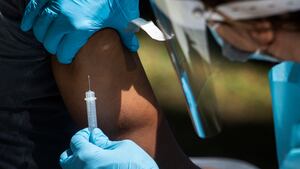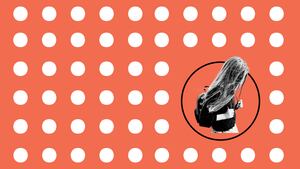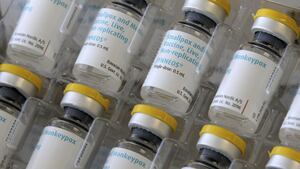As the American monkeypox outbreak continues to outpace attempts to slow its spread, public health authorities are relying on just one type of test to confirm cases of the virus—the one that requires technicians to swab open lesions.
But with testing at only one-tenth of the nation’s capacity, a growing number of clinicians, epidemiologists and infectious disease specialists are concerned that only testing people with lesions may delay treatment for people who have contracted the illness—and are preventing scientists from understanding the full scale of the epidemic.
“There are ways to detect this virus without having somebody drop their pants and rub a swab over a bump on their penis or anything else,” said Dr. Jay Varma, a professor at Cornell University’s Center for Pandemic Prevention and Response. “One of the things that I’ve been concerned about is that with all the emphasis on drugs and vaccines, people are missing the importance of testing.”
The Food and Drug Administration requires clinicians to exclusively test for the virus by swabbing lesions—preferably at least three, if not more—before submitting the samples for testing by the Centers for Disease Control and Prevention or a private testing company. But the number of tests being performed weekly—roughly 8,000 in the week ending July 29—represent only about 10 percent of the nation’s 80,000 test capacity, an indication that testing facilities and public health authorities have the potential bandwidth to conduct a much wider variety of tests, from a much wider array of samples.
The FDA, according to a testing guidance for clinicians released in mid-July, contends that it is “not aware of clinical data supporting the use of other sample types, such as blood or saliva, for monkeypox virus testing.” In a conference call with reporters last month, CDC director Dr. Rochelle Wolensky said that, “by definition, if you don’t have a lesion, it’s hard to do the test.”
“You do need to have a lesion in order to get a test,” Wolensky said.
But many epidemiologists and infectious disease experts have pointed to early studies out of Europe—where the current monkeypox outbreak was first noticed by public health authorities—indicating that oral or rectal swabs could provide a quicker diagnosis, and may give epidemiologists a better sense of the true positivity rate.
“This is important to help us better understand the risk of transmission and routes of transmission,” Dr. Abraar Karan, an infectious disease researcher at Stanford University, told The Daily Beast. Karan said expanding testing to include other body sites “would provide important information” for those studying a virus that has rapidly challenged previous assumptions about how it is transmitted.
The virus that causes monkeypox—which, despite its name, is found primarily in rodents—was first discovered in the 1970s. Cases had been almost entirely limited to Central and West Africa until this spring, when a series of outbreaks first detected in Europe were linked to large gatherings of men who have sex with men. Since then, more than 30,000 people around the world—almost all gay and bisexual men—have been infected with the virus. Monkeypox’s most identifiable symptom is the presence of blister-like lesions on the hands, mouth and genitals, which can be deeply painful and leave permanent scars, particularly in areas where the virus was likely contracted through sexual contact.
Those lesions have been the FDA’s sole source of testing samples since the early days of the American outbreak, when testing for monkeypox faced high bureaucratic hurdles and local health authorities only had a weekly testing capacity in the dozens. Since then, the national capacity for monkeypox testing has reached 80,000 per week.
According to Kevin Griffis, a CDC spokesperson, the 8,000 tests conducted in the week ending July 29 represents an increase of more than 3,000 tests compared to the previous week.
Many of those 8,000 tests, however, are from multiple samples of the same patients, which has made determining the positivity rate of the American outbreak difficult. Positivity rates are often critical tools in understanding how well an illness is being controlled, a lesson learned the hard way during the early days of the COVID-19 pandemic, when the Trump administration sought to downplay testing that showed uncontrolled spread of the illness.
Experts in epidemiology and infectious disease treatment say the lesion-only approach to testing could be missing many cases in the earlier stage of infection. They point to promising European studies indicating that tests can identify some monkeypox cases through a single oral swab—meaning people could be tested before they start showing the classic symptoms of the disease.
Doing so, Varma said, would allow for earlier treatment and less potential spread from undiagnosed people in group settings.
“Early on an outbreak you only catch the most extreme cases, right? You don’t catch lower-level cases, and that distorts your understanding of how severe the disease is and how much it’s spread,” Varma said. The slow testing protocols, he added, also prevent public health authorities from enacting some of the tactics that have been used in testing campaigns for sexually transmitted infections.
“One of things we learned from STIs and HIV is that the best places to screen for those diseases are at locations where people at highest risk congregate: bathhouses, gay dance clubs, raves, things like that,” Varma said. “So if the tests we have were more easily administered, we would then be able to more rapidly identify cases and then either get them treatment and separate them from other people.”
The FDA did not respond to a request for comment on whether it was reconsidering the guidance on using lesion-only testing samples to diagnose monkeypox cases, but a paper published in The Lancet on Tuesday did add credibility to the argument that lesion samples are the most straightforward diagnostic tool for clinicians.
According to the paper, viral loads in lesions were more than 1,000 times higher than those found in respiratory samples—bolstering the contention that a lesion test is less likely to produce false positives or negatives than a throat swab.
But with the Department of Health and Human Services officially deeming the outbreak a public health emergency, experts say a wider net is necessary to get ahead of a virus that threatens to become endemic in queer communities.
“We have to have real-time surveillance and widespread testing on all those who exhibit symptoms consistent with monkeypox infection,” said Lawrence Gostin, director of the O’Neill Institute for National and Global Health Law at Georgetown Law Center. “While the CDC’s lesion-only testing is a gold standard, it is too cumbersome and time-consuming to get tests on the scale needed for this emergency. Making testing easier for patients and physicians, and fully accessible, is essential now.”
The European studies, like much of the science surrounding a monkeypox outbreak that has challenged many previous assumptions about the virus, are preliminary. But the early indications, though not yet peer reviewed, are that monkeypox can be detected by testing bodily fluids. One study conducted in the Democratic Republic of Congo and published in May found that monkeypox’s genetic material could be detected by both blood draws and throat swabs before the onset of the telltale lesions.
Identifying cases before the onset of lesions could prevent monkeypox’s spread by alerting patients to avoid contact before an unnoticed lesion presents itself, though whether the illness is contagious before the rash appears is still being studied. Such tests could also catch cases where lesions are internal or go unnoticed; some partially vaccinated monkeypox patients have reported only a few less-noticeable lesions, sometimes with no pain.
At a minimum, Karan said, the tests would provide more data to study amidst an outbreak that has stymied many of those attempting to curb its spread.
“These are important studies that are ongoing,” Karan said. “When do certain clinical sites turn positive? For how long, and do they have viable virus, and for how long?”
Most importantly, however, expanded testing tactics could prevent needless suffering.
“We can't make policy decisions about allocation of vaccines and treatments unless we have a real time understanding of how monkeypox is spreading in the U.S. and in what locations and communities,” Gostin said.
Delays in access, Gostin added, “are unacceptable.”










